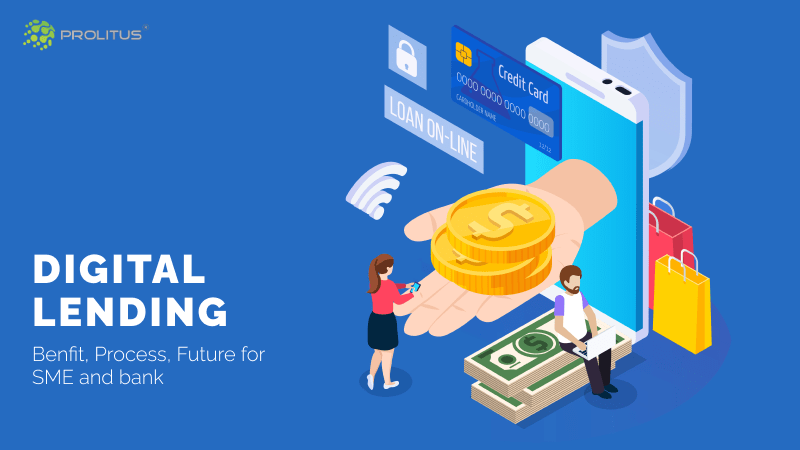Lending services constitute one of the biggest revenue streams for financial institutions. But the traditional lending process isn’t efficient and needs to be changed with new technologies and digitization. So, to override all of these issues, digital lending came into existence.
With the help of digital lending, the entire lending sector is undergoing a big revolution as customers won’t have to wait long hours for loans.
Moreover, financial institutions will also be able to process more loans at a lower cost, directly boosting their revenue. Thus, in this article, we will cover everything around digital lending, from the benefits of digital lending to its effects on SMEs and banks.
What is Digital Lending?
Digital lending is a technological advancement in the lending and borrowing space. It empowers financial institutions by improving productivity, reducing the time to deliver loans, and increasing the revenue behind every disbursed loan.
Moreover, as everything is now digital, anyone can apply for a loan while sitting in any corner of the world with just a few clicks. Thus, businesses and individuals won’t have to wait long to receive the required loans.
Furthermore, as technology is taking the lead, lenders’ sensitive details can be protected better. So, digital lending undoubtedly makes the entire lending and borrowing process easy, secure, and quick.
Benefits of Digital Lending
There are various benefits associated with digital lending services, but in this section, we will focus on some of the most prominent ones. So let’s have a look over them one by one.
-
Easiness in capturing applicant’s information digitally
One of the biggest advantages of digital lending is that it overcomes the limitations of demographics. Applicants can apply for loans from any corner of the world and at any point in time, as they don’t need to physically visit a financial institution’s branch. Instead, each and everything can be done digitally, which even reduces the human error rate made while filling out the form physically.
Moreover, with advanced technologies like eKYC, the applicant’s identity can be easily verified. This further adds to the transparency and authenticity of applications.
Finally, as all the details are captured digitally, a database can be maintained, which will help analyze and quickly address any issues in the leading tenure.
-
Increases the efficiency of the lending cycle
The efficiency of the traditional lending system is very low as it requires human intervention at every step, and humans are prone to mistakes.
So, the more the number of steps, the more the chances of mistakes. But this is no longer the case with digital lending as everything is digitalized, reducing overheads by almost 40-50%.
Moreover, the time and costs associated with the entire loan cycle are also reduced by a significant percentage as there is no longer a requirement for huge staff and vendor administration. Thus, the entire lending process is automated, making it highly efficient.
-
Opens up doors for borrowers with no credit history
It is tough to get a loan if one doesn’t have a credit history, as traditional lending institutions rely significantly on good credit scores and credit history.
So small businesses and young individuals who haven’t taken any loans in the past suffer the most when trying to get a loan from the traditional medium. But with digital lending, this issue can be tackled as digital lending institutions focus on various alternative credit check mechanisms for first-time borrowers.
In this manner, short-term loans can be easily obtained by customers with no credit history, and financial institutions also get a new customer base to serve. This way, both lenders and borrowers enjoy a win-win situation.
-
Overrides long waiting times with quick decision-making
In this digital world, no one wants to wait for days just to approve their loan and then again wait for some more days before they get the loan amount.
So with digital lending, the loan approval process can be completed within a few minutes, not even hours. And as soon as the loan is approved, it gets credited to the borrower’s account.
This is possible because digital lending uses automated decision-making systems powered by advanced technologies like AI, ML, cloud computing, etc. Thus, with digital lending, instant loans have become the new norm.
Step-by-Step Digital Lending Process
Below is the complete step-by-step digital lending process, which covers the entire loan cycle. So let’s go through this process in detail.
-
Acquisition of Customers
The first and foremost task is to acquire customers, which is, to be honest, the most challenging part due to the stiff competition among financial institutions. However, digital marketing channels can enhance customer acquisition with the help of new-age technologies. The most prominent channels include online banners, targeted advertising, social media campaigns, SEO blogs, etc.
Moreover, web apps and digital onboarding tools can help acquire new customers. However, in all of this, it doesn’t mean that traditional marketing strategies won’t work in the digital world. For example, as lending and borrowing are based on mutual trust, traditional marketing channels also play a crucial role in acquiring customers.
-
Analysis and Approval of Application
Now that customer acquisition is made, it’s time to decide whether to approve the loan application or not. Thus, this is one of the most crucial steps of the loan cycle.
Lenders have been using the same old underwriting process since lending and borrowing products were introduced in the financial market.
And one of the biggest drawbacks of this process is that it takes a lot of time and is highly inefficient. But with digital lending, the entire scenario has changed, and it hardly requires a few minutes to accept or reject a particular application.
Highly advanced algorithms and analysis mechanisms currently handle everything from generating a personalized score to making a credit decision.
And all of this becomes possible with the help of data from social channels, credit bureaus, and digital documents submitted by the customer.
Moreover, verification of the customer’s documents can be done easily with the help of eKYC, which also reduces the risk of default.
A Loan Origination System (LOS) is one such kind of software that pulls all the customer data from relevant sources, calculates the credit score, and finally takes the loan decision. Everything is automated, super fast, and requires the least human intervention.
-
Disbursing loans and collecting EMIs
As the loan is approved within a few minutes, it’s time to disburse it as soon as possible. Traditionally, lenders used to take a day or so to deposit the loan amount into the borrower’s account. But with digital lending, the loan can be processed within a fraction of a second through mobile banking or e-wallets.
Moreover, as the entire process is carried out through a cashless medium, lenders keep track of the entire trail of transactions, thus decreasing the chances of fraud.
Additionally, collecting EMIs is easy as borrowers can use the lenders’ mobile application or website for the repayments. This further adds flexibility and increases transparency between both parties.
A Loan Collection System is one such software that can help lenders with the entire process of disbursing loans and collecting EMIs.
Furthermore, it can also help track the repayments of a customer, raise an alert in case of default on the EMI, and even help restructure the loan.
-
Establishing lender-borrower relationship
Customer satisfaction is an essential part of establishing a high-quality customer relationship. However, it is mostly considered as the last step of the lending cycle, but to be honest, customer engagement is part of every other step we just covered.
If the customers are happy with the services of a lender, then they will, by default, become lifetime customers.
So, with digital lending, as everything is now stored in a centralized database, lenders can leverage it to offer personalized solutions and offers to their customers.
Moreover, to increase customer satisfaction, lenders can send friendly reminders for loan repayments so customers don’t miss any EMI.
Lenders can even provide 24*7 customer support in case of any issue or complaint in the ongoing loan cycle. Thus, nurturing customers in every possible way ensures they don’t move away from other players.
Effects of Digital Lending on SMEs and Banks
Small and Medium Enterprises (SMEs) have suffered the most in terms of applying for loans and waiting for a long time just to hear that their application has been rejected. Moreover, after the Covid-19 pandemic, these small businesses are much more stressed and need immediate funds to survive tough times. This is when digital lending has come forward to help them.
Traditional banks won’t generally take care of these small businesses as they have low credit history and often need small amounts, which doesn’t bring in more profits. Instead, they keep their doors open for multinational companies as they have significant transaction history and can take massive loans.
But this scenario is changing as traditional banks are no longer missing out on SMEs but rather a whole new set of individuals who prefer FinTech companies over traditional banks. Primarily because they highly rely on advanced technology and digital lending, which makes the entire process smooth, fast, and cost-efficient.
According to EY Global Banking Outlook 2022, more than 56% of SMEs use digital banking and lending services from FinTech companies.
Thus, traditional banks will need to adapt to new technologies and shift their focus from physical banking to digital services.
Moreover, according to Grand View Research, the market size of digital lending services will grow at a CAGR of 25.9% from 2022 to 2030.
Thus, to grab a piece of the ever-expanding market, traditional banks have started transforming themselves, and the credit solely goes to digital lending.
Why should you hire Prolitus?
We at Prolitus are a leading blockchain development company in the crypto space. Our team comprises more than 200 highly skilled, techno-savvy professionals and ingenious management. Moreover, we offer a wide variety of services, which include:
- Blockchain Development
- NFT Development
- NFT Marketplace Development
- NFT Gaming Platform Development
- DeFi Decentralized Finance Development
- Smart Contract Development
- Metaverse Development
- White label exchange
- Wallet development
- Coin Development
- Tokenization
So, whatever your business requirements and needs are, our team can easily handle them and deliver your dream project in the best possible timeframe and budget.
Final Thoghts
Digital lending systems are quickly taking over the traditional lending mechanism with the help of advanced technologies like AI, ML, Blockchain, Cloud computing, etc.
Moreover, SMEs and individuals don’t need to wait long as the entire process of verifying and approving loan applications and even disbursing the loan amount hardly takes a few minutes.
According to a survey by the Reserve Bank of Boston, more than 89% of credit unions and banks offer mobile banking services to their customers.
Thus as time passes, more and more financial institutions will move to digital space to offer much better services at low cost and lightning speed.
So if you are also thinking of moving digital and leveraging upon the new emerging technologies like Blockchain, then it’s the right time.
Prominent companies in this space, like Prolitus, can help you serve various services. So just contact us and let our experts handle all your requirements and queries.



